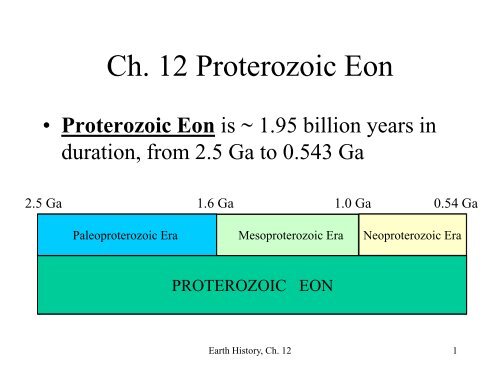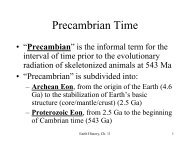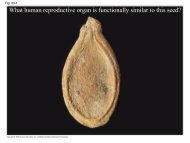Ch 12 Proterozoic Eon
Proterozoic Eon
Proterozoic Eon
- No tags were found...
You also want an ePaper? Increase the reach of your titles
YUMPU automatically turns print PDFs into web optimized ePapers that Google loves.
<strong>Ch</strong>. <strong>12</strong> <strong>Proterozoic</strong> <strong>Eon</strong><br />
• <strong>Proterozoic</strong> <strong>Eon</strong> is ~ 1.95 billion years in<br />
duration, from 2.5 Ga to 0.543 Ga<br />
2.5 Ga 1.6 Ga<br />
1.0 Ga 0.54 Ga<br />
Paleoproterozoic Era Mesoproterozoic Era Neoproterozoic Era<br />
PROTEROZOIC EON<br />
Earth History, <strong>Ch</strong>. <strong>12</strong> 1
Early <strong>Proterozoic</strong> Life<br />
• Stromatolites<br />
continued to increase<br />
in abundance,<br />
especially after 2.2<br />
Ga, probably because<br />
of the establishment<br />
of broad continental<br />
shelves<br />
Earth History, <strong>Ch</strong>. <strong>12</strong> 2
Modern<br />
stromatolite<br />
structure<br />
Earth History, <strong>Ch</strong>. <strong>12</strong> 3
<strong>Proterozoic</strong><br />
stromatolites<br />
Earth History, <strong>Ch</strong>. <strong>12</strong> 4
<strong>Proterozoic</strong><br />
bacterial<br />
filaments<br />
(prokaryotes)<br />
Earth History, <strong>Ch</strong>. <strong>12</strong> 5
Early <strong>Proterozoic</strong> life<br />
• Earliest fossil evidence of eukaryotes is<br />
single-celled algae (protists), ~2.1 Ga,<br />
although indirect genetic evidence suggests<br />
the possibility of Archean eukaryotes<br />
• Eukaryotic cell probably originated from<br />
the union of two prokaryotic cells, with one<br />
engulfing the other (“endosymbiont<br />
theory”)<br />
Earth History, <strong>Ch</strong>. <strong>12</strong> 6
Endosymbiont theory<br />
• Cytoskeleton (fibers just inside cell<br />
membrane) allows cell to change shape–<br />
makes engulfing possible (adaptive<br />
breakthrough)<br />
• Simple protists could have engulfed<br />
chlorophyll-bearing cyanobacteria to<br />
become plant-like protists (algae)<br />
Earth History, <strong>Ch</strong>. <strong>12</strong> 7
Endosymbiont theory<br />
In modern eukaryotes, DNA<br />
and RNA of mitochondria<br />
and chloroplasts differ from<br />
that in the nucleus,<br />
suggesting separate origins<br />
Earth History, <strong>Ch</strong>. <strong>12</strong> 8
Lynn Margulis<br />
• National Academy of Sciences<br />
• Russian Academy of Natural Sciences<br />
• American Academy of Arts and<br />
Sciences<br />
• Proctor Prize<br />
• National Medal of Science<br />
• Linnean Society of London<br />
• Darwin-Wallace Medal<br />
• Papers archived in Library of Congress<br />
Earth History, <strong>Ch</strong>. <strong>12</strong> 9
Early <strong>Proterozoic</strong> life<br />
• Even after the origin of eukaryotes, prokaryotes<br />
were dominant until about ~1.9 Ga—what<br />
happened then?<br />
• Build-up of atmospheric oxygen was achieved<br />
by ~1.9 Ga, as evidenced by decrease in banded<br />
iron formations and appearance of “red beds”<br />
(oxidized sediments)<br />
• O 2 combined with N 2 to form nitrates (NO 3 ),<br />
which acted as “fertilizer” to accelerate the<br />
evolution of eukaryotic algae<br />
Earth History, <strong>Ch</strong>. <strong>12</strong> 10
Early<br />
<strong>Proterozoic</strong> life<br />
1.9 Ga prokaryotes from<br />
the Gunflint Formation<br />
of Ontario, Canada<br />
Note small size<br />
Earth History, <strong>Ch</strong>. <strong>12</strong> 11
Early <strong>Proterozoic</strong> life<br />
Single-celled, eukaryotic<br />
algae–acritarchs–became<br />
abundant after ~1.9Ga<br />
Acritarchs are relatively<br />
large and possess a complex<br />
cell wall. Probably related<br />
to modern planktonic algae<br />
(dinoflagellates)<br />
35µm<br />
Earth History, <strong>Ch</strong>. <strong>12</strong> <strong>12</strong>
<strong>Proterozoic</strong><br />
acritarchs<br />
Bar scale = 10 µm<br />
Earth History, <strong>Ch</strong>. <strong>12</strong> 13
Neoproterozoic life<br />
• Transition from Mesoproterozoic to<br />
Neoproterozoic was marked by an adaptive<br />
radiation of eukaryotes at ~1.0 Ga<br />
– Mainly an increase in the diversity of acritarchs<br />
• But, by the end of <strong>Proterozoic</strong> time,<br />
stromatolites had declined in abundance<br />
and unquestioned multicellular animals<br />
had spread to many regions of the Earth<br />
Earth History, <strong>Ch</strong>. <strong>12</strong> 14
Neoproterozoic life<br />
• The evolutionary radiation of animals<br />
– Beginning at ~570 Ma, rocks contain evidence<br />
of diverse animal life<br />
• Trace fossils<br />
• Animal embryos<br />
• Impressions of soft-bodied fossils<br />
• Skeletal fossils<br />
Earth History, <strong>Ch</strong>. <strong>12</strong> 15
Neoproterozoic life<br />
• Trace fossils<br />
– Burrows, tracks, trails<br />
– Not known in rocks<br />
older than ~570 Ma*<br />
– Their presence is good<br />
evidence for animal<br />
activity<br />
*hold that thought<br />
Late <strong>Proterozoic</strong> feeding<br />
burrows from Norway<br />
Earth History, <strong>Ch</strong>. <strong>12</strong> 16
animal<br />
embryos<br />
(570 Ma)<br />
from <strong>Ch</strong>ina<br />
Earth History, <strong>Ch</strong>. <strong>12</strong> 17
Neoproterozoic life<br />
• Impressions from the<br />
Ediacara Hills region of<br />
Australia (“Ediacara<br />
Fauna”)<br />
Primitive<br />
mollusk<br />
“Sea pen”<br />
(cnidarian)<br />
Worm/arthropod?<br />
Segmented form<br />
Earth History, <strong>Ch</strong>. <strong>12</strong> 18
Neoproterozoic<br />
life<br />
• Skeletal fossils<br />
include the calcitic,<br />
tube-like Cloudina<br />
Earth History, <strong>Ch</strong>. <strong>12</strong> 19
Neoproterozoic life<br />
• Thus, by the end of <strong>Proterozoic</strong> <strong>Eon</strong>, at least four<br />
major groups of animals had arisen<br />
– Segmented worms, arthropods, cnidarians, mollusks<br />
• What triggered the initial radiation of animals?<br />
– Critical build-up of atmospheric O 2 ?<br />
– Evolution of key adaptive features such as muscle cells<br />
or nerve cells?<br />
• Answer is still unknown!<br />
Earth History, <strong>Ch</strong>. <strong>12</strong> 20
Addendum (2002 news!)<br />
Probable trace fossils<br />
> 1.2 Ga from SW<br />
Australia<br />
Discovery suggests a<br />
much earlier origin of<br />
active organisms than<br />
previously thought<br />
Rasmussen et al. 2002, Science<br />
Earth History, <strong>Ch</strong>. <strong>12</strong> 21
<strong>Proterozoic</strong> life (review)<br />
oldest evidence for animals *<br />
adaptive radiation of acritarchs *<br />
* oxygenation of atmosphere<br />
eukaryotes<br />
?<br />
prokaryotes<br />
2.5 Ga 2.1 1.9<br />
1.2 1.0 0.57<br />
Earth History, <strong>Ch</strong>. <strong>12</strong> 22
Oxygenation of the atmosphere<br />
• Most iron-bearing sedimentary deposits younger<br />
than 1.9 billion are highly oxidized (red beds)<br />
• Cessation of Banded Iron Formation deposition<br />
– BIFs are alternating bands of iron-rich layers and<br />
chert layers<br />
– Very few BIFs younger than 1.9 billion years old (when<br />
atmospheric O 2 increased)<br />
– Principal source of world’s iron ore<br />
Earth History, <strong>Ch</strong>. 11 23
Banded iron formations<br />
Earth History, <strong>Ch</strong>. <strong>12</strong> 24
Oxygenation of the atmosphere<br />
Fe ++ was dissolved in oceans before<br />
oxygenation of the atmosphere<br />
Once O 2 became plentiful in atmosphere<br />
and oceans, Fe ++ became oxidized and was<br />
precipitated as banded iron formations<br />
Fe ++ oxidation<br />
Fe +++ + e -<br />
soluble<br />
(ferrous)<br />
insoluble<br />
(ferric)<br />
Earth History, <strong>Ch</strong>. 11 25
<strong>Proterozoic</strong> continents<br />
• Major cratons were assembled by the<br />
suturing of protocontinents<br />
• Once cratons formed, incremental growth of<br />
continents occurred through continental<br />
accretion<br />
Earth History, <strong>Ch</strong>. <strong>12</strong> 26
Continental<br />
accretion<br />
• Lateral growth of a<br />
continental margin by<br />
suturing of a microplate<br />
and/or compression and<br />
metamorphism of<br />
sediments<br />
Earth History, <strong>Ch</strong>. <strong>12</strong> 27
Assembly of North America<br />
• Laurentia = <strong>Proterozoic</strong><br />
combined landmass of<br />
North America and<br />
Greenland<br />
– Core of Laurentia was<br />
North American craton<br />
(now exposed in Canadian<br />
Shield)<br />
• Throughout <strong>Proterozoic</strong><br />
time, Laurentia grew by<br />
continental accretion<br />
Earth History, <strong>Ch</strong>. <strong>12</strong> 28
Assembly of Laurentia<br />
• First step in assembly of Laurentia was the<br />
fusion of six Archean protocontinents to form<br />
the stable craton<br />
– Suturing of protocontinents occurred from 1.95–<br />
1.85 Ga<br />
– Trans-Hudson belt is metamorphosed suture<br />
zone between Superior protocontinent and<br />
Wyoming-Hearne protocontinent<br />
Earth History, <strong>Ch</strong>. <strong>12</strong> 29
Assembly of Laurentia<br />
Earth History, <strong>Ch</strong>. <strong>12</strong> 30
Assembly of Laurentia<br />
• Second major step was continental<br />
accretion of central and southern U.S. (1.8-<br />
1.6 Ga)<br />
• Third step was Grenville Orogeny<br />
– Collision of eastern Laurentia with northern<br />
South America, ~1.2–1.0 Ga<br />
– Resulted in continental accretion along entire<br />
eastern margin of Laurentia<br />
Earth History, <strong>Ch</strong>. <strong>12</strong> 31
Assembly of Laurentia<br />
Earth History, <strong>Ch</strong>. <strong>12</strong> 32
Midcontinent rift<br />
•Midcontinent Rift formed at about same time as<br />
Grenville orogeny (~1.2 to 1.0 Ga), but relationship<br />
is unclear<br />
–Split in continental crustrifting filling of elongate<br />
basins with Keweenawan basalts<br />
Earth History, <strong>Ch</strong>. <strong>12</strong> 33
Continental rift sequence<br />
Earth History, <strong>Ch</strong>. <strong>12</strong> 34
Earth History, <strong>Ch</strong>. <strong>12</strong> 35
Midcontinent<br />
rift system<br />
Earth History, <strong>Ch</strong>. <strong>12</strong> 36
Gravity<br />
survey<br />
Earth History, <strong>Ch</strong>. <strong>12</strong> 37
Assembly of Laurentia<br />
Earth History, <strong>Ch</strong>. <strong>12</strong> 38
Assembly of the supercontinent<br />
Rodinia<br />
• Grenville orogenic belt<br />
was connected to<br />
orogenic belts along<br />
margins of southern<br />
Africa, India, Australia<br />
and Antarctica<br />
• By ~1.0 Ga all these<br />
continental areas had<br />
merged to form the<br />
supercontinent Rodinia<br />
Earth History, <strong>Ch</strong>. <strong>12</strong> 39
Breakup of Rodinia<br />
• Rodinia split in half<br />
at ~800–700 Ma<br />
• This rift created the<br />
Pacific Ocean<br />
Earth History, <strong>Ch</strong>. <strong>12</strong> 40
Breakup of Rodinia—another<br />
failed rift<br />
Earth History, <strong>Ch</strong>. <strong>12</strong> 41
End of Precambrian<br />
• By end of Precambrian time, Laurentia,<br />
Baltica, and Siberia were distinct<br />
continents<br />
• Pan-African suturing resulted in the<br />
formation of the supercontinent<br />
“Gondwanaland” (Africa, South America,<br />
India, Australia, Antarctica)<br />
Earth History, <strong>Ch</strong>. <strong>12</strong> 42
Earth History, <strong>Ch</strong>. <strong>12</strong> 43
Gondwana<br />
Laurentia<br />
Siberia<br />
Earth History, <strong>Ch</strong>. <strong>12</strong> 44
Iowa’s Precambrian record<br />
• Only Precambrian rocks exposed at surface are in<br />
northwestern corner of state in Gitchie<br />
Manitou State Preserve<br />
– Sioux Quartzite (~1.7 Ma) (deposited after Trans-<br />
Hudson Belt but before Midcontinent Rift)<br />
• Best record of Precambrian rocks in subsurface is<br />
Amoco Eischeid well (Carroll County)<br />
– ~15,000 ft of late <strong>Proterozoic</strong> sedimentary rocks that<br />
filled the Midcontinent Rift valley above Keweenawan<br />
basalts<br />
Earth History, <strong>Ch</strong>. <strong>12</strong> 45
Earth History, <strong>Ch</strong>. <strong>12</strong> 46
Sioux Quartzite<br />
southern Minnesota ~1900<br />
Earth History, <strong>Ch</strong>. <strong>12</strong> 47
“Pipestone” figurines<br />
Earth History, <strong>Ch</strong>. <strong>12</strong> 48
Snowball Earth??<br />
Locations of known glacial till deposits of Late <strong>Proterozoic</strong> age<br />
Earth History, <strong>Ch</strong>. <strong>12</strong> 49
Tillite overlain by limestone<br />
Earth History, <strong>Ch</strong>. <strong>12</strong> 50
Snowball Earth?<br />
Earth History, <strong>Ch</strong>. <strong>12</strong> 51
570 Ma<br />
Earliest evidence of<br />
multicellular animals<br />
is immediately after<br />
“Snowball Earth” period<br />
Earth History, <strong>Ch</strong>. <strong>12</strong> 52





